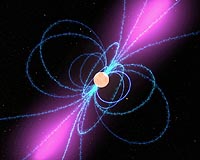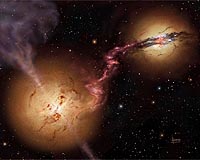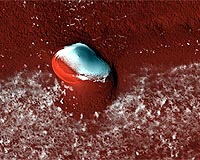| October 17, 2008 |  |
SpaceDaily Advertising Kit |
|
NASA's Fermi Telescope Discovers First Gamma-Ray-Only Pulsar Washington DC (SPX) Oct 17, 2008  About three times a second, a 10,000-year-old stellar corpse sweeps a beam of gamma-rays toward Earth. Discovered by NASA's Fermi Gamma-ray Space Telescope, the object, called a pulsar, is the first one known that only "blinks" in gamma rays. "This is the first example of a new class of pulsars that will give us fundamental insights into how these collapsed stars work," said Stanford ... read more
About three times a second, a 10,000-year-old stellar corpse sweeps a beam of gamma-rays toward Earth. Discovered by NASA's Fermi Gamma-ray Space Telescope, the object, called a pulsar, is the first one known that only "blinks" in gamma rays. "This is the first example of a new class of pulsars that will give us fundamental insights into how these collapsed stars work," said Stanford ... read moreThe Changing Landscape Of The Teleport Sector  New York NY (SPX) Oct 17, 2008
New York NY (SPX) Oct 17, 2008World Teleport Association (WTA) has announced the publication of a new report, New Markets, New Services, New Competition addressing the changing applications, technologies and competitive dynamics of the global teleport sector. For the report, WTA surveyed senior executives of companies at the core of its membership - teleport operators delivering customized communications services in ... more |
G20 billionaires could end world poverty in one year's earnings: Oxfam
Australia set to cede COP31 hosting rights to Turkey COP30 dragged into clash over gender language Brazil's Lula hunts for deal at Amazon climate summit EU states back new delay to anti-deforestation rules Lula lands in Amazon to press for climate deal To combat climate anxiety, COP negotiator recommends meditation Nations 'still far' from deal at UN climate talks: France Nearly a third of women face partner or sexual violence: WHO Belgian climate case pits farmer against TotalEnergies
|
|
| Previous Issues | Oct 16 | Oct 15 | Oct 14 | Oct 13 | Oct 12 |
Phoenix Mars Mission Honored By Popular Mechanics Pasadena CA (SPX) Oct 17, 2008
Pasadena CA (SPX) Oct 17, 2008NASA's Phoenix Mars Mission is being honored with a Breakthrough Award by Popular Mechanics magazine in New York City. In its fourth year, the awards recognize innovators who improve lives and expand possibilities in science, technology, engineering and exploration. Peter Smith of the University of Arizona, principal investigator for Phoenix, is accepting the award on behalf of the Phoenix ... more Hubble Status Report: Instruments Checked  Greenbelt MD (SPX) Oct 17, 2008
Greenbelt MD (SPX) Oct 17, 2008During the night of Oct. 15, Space Telescope Operations Control Center engineers at NASA's Goddard Space Flight Center turned on and checked out Side 'B' of Hubble's Science Instrument Control and Data Handling (SIC and DH) system. Subsequently, the Advanced Camera for Surveys (ACS), Wide Field Planetary Camera 2 (WFPC2) and Near Infrared Camera and Multi-Object Spectrometer (NICMOS) ... more Ghostly Glow Reveals Galaxy Clusters In Collision  Washington DC (SPX) Oct 17, 2008
Washington DC (SPX) Oct 17, 2008A team of scientists, including astronomers from the Naval Research Laboratory (NRL), have detected long wavelength radio emission from a colliding, massive galaxy cluster which, surprisingly, is not detected at the shorter wavelengths typically seen in these objects. The discovery implies that existing radio telescopes have missed a large population of these colliding objects. It also ... more |
blackhole:
 gamma:  mars-mro:  |
Young Earthlike Planets May Glow Brightly Enough To Be Found Boston MA (SPX) Oct 17, 2008
Boston MA (SPX) Oct 17, 2008Hot, young planets may be easier to spot because they stay that way longer than astronomers have thought, according to new work by MIT planetary scientist Linda Elkins-Tanton. For a few million years after their initial formation, planets like Earth may maintain a hot surface of molten rock that would glow brightly enough to make them stand out as they orbit neighboring stars. Elkins ... more Quantum Mechanical Hurricanes Form Spontaneously  Tucson AZ (SPX) Oct 17, 2008
Tucson AZ (SPX) Oct 17, 2008University of Arizona scientists experimenting with some of the coldest gases in the universe have discovered that when atoms in the gas get cold enough, they can spontaneously spin up into what might be described as quantum mechanical twisters or hurricanes. The surprising experimental results agree with independent numerical simulations produced by collaborating scientists at the ... more Great World Wide Star Count Starts 20th October  Boulder CO (SPX) Oct 17, 2008
Boulder CO (SPX) Oct 17, 2008Schoolchildren, families, and citizen scientists around the world will gaze skyward after dark from October 20 to November 3, looking for specific constellations and then sharing their observations through the Internet. The Great World Wide Star Count, now in its second year, helps scientists map light pollution globally while educating participants about the stars. The event, which ... more ESA Closes In On The Origin Of Mars' Larger Moon  Parsi, France (ESA) Oct 17, 2008
Parsi, France (ESA) Oct 17, 2008European space scientists are getting closer to unravelling the origin of Mars' larger moon, Phobos. Thanks to a series of close encounters by ESA's Mars Express spacecraft, the moon looks almost certain to be a 'rubble pile', rather than a single solid object. However, mysteries remain about where the rubble came from. Unlike Earth, with its single large moon, Mars plays host to two ... more |
satellite-biz:
 abm:  nuclear-doctrine:  |
| Previous Issues | Oct 16 | Oct 15 | Oct 14 | Oct 13 | Oct 12 |
| The contents herein, unless otherwise known to be public domain, are Copyright 1995-2008 - SpaceDaily. AFP and UPI Wire Stories are copyright Agence France-Presse and United Press International. ESA Portal Reports are copyright European Space Agency. All NASA sourced material is public domain. Additional copyrights may apply in whole or part to other bona fide parties. Advertising does not imply endorsement, agreement or approval of any opinions, statements or information provided by SpaceDaily on any web page published or hosted by SpaceDaily. Privacy statement |